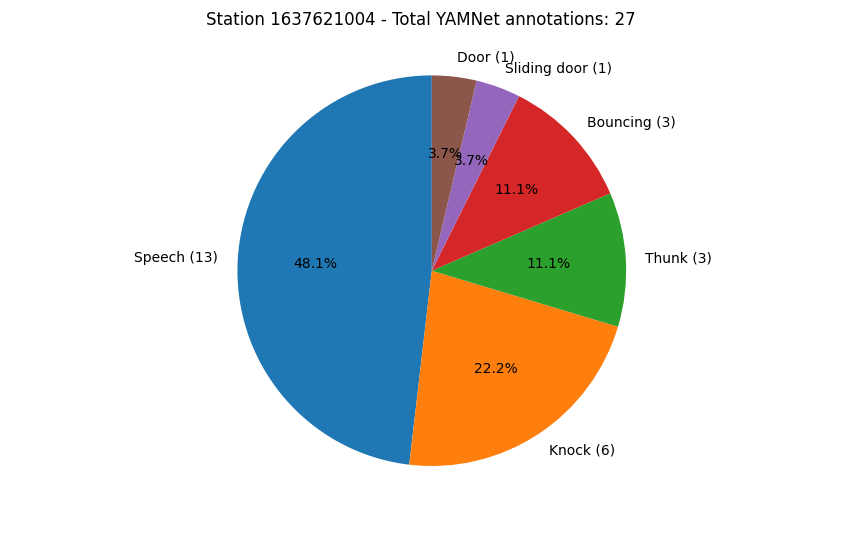Use the YAMNet CSV#
At the end of the previous example, we downloaded a CSV file with basic information about the YAMNet classifications. In this example, we will demonstrate how to use this file to display part of the data.
NOTE: To reproduce the results in this example, download the YAMNet classification timeline (.csv) in the Additional Products section in this report.
Running the Example#
First, we will read the CSV file and display the columns’ titles.
import pandas as pd
# Input path to CSV downloaded from report
input_file: str = "path/to/yamnet/data/YAMNet.csv"
# Load CSV
df = pd.read_csv(input_file)
print(f'Available columns: {df.columns.values}')
Now that we’ve confirmed we can read the CSV, we’ll focus on the classification that YAMNet thinks is the most likely.
In the file, this classification is named class_0. It is accompanied by the confidence score score_0.
import pandas as pd
from typing import Dict
# Input path to CSV downloaded from report
input_file: str = "path/to/yamnet/data/YAMNet.csv"
# Load CSV
df = pd.read_csv(input_file)
print(f'Available columns: {df.columns.values}')
# Get ID of stations
stations = df["Station ID"].unique()
# for each of the stations, perform these tasks
for station in stations:
# Get rows with station ID specific information
df_station = df.loc[df['Station ID'] == station]
# only look at the most likely classification
dict_counts = df_station["class_0"].value_counts().to_dict()
# Get index of max and min yamnet scores
idx_max_score = df_station["score_0"].idxmax()
idx_min_score = df_station["score_0"].idxmin()
# Get names of most and least frequent class names
most_frequent_class = df_station["class_0"].mode()[0]
least_frequent_class = min(dict_counts, key=dict_counts.get)
# Calculate average yamnet score per classification name
dict_avg_scores: Dict = {}
for idx, class_name in enumerate(dict_counts.keys()):
df_class_name = df_station.loc[df_station['class_0'] == class_name]
dict_avg_scores[f"{class_name}"] = "{0:.3f}".format(df_class_name['score_0'].mean())
Our statistics have been gathered, so we will now plot the results as a pie chart:
import pandas as pd
import matplotlib.pyplot as plt
from typing import Dict
# Input path to CSV downloaded from report
input_file: str = "path/to/yamnet/data/YAMNet.csv"
# Load CSV
df = pd.read_csv(input_file)
print(f'Available columns: {df.columns.values}')
# Get ID of stations
stations = df["Station ID"].unique()
for station in stations:
# Get rows with station ID specific information
df_station = df.loc[df['Station ID'] == station]
dict_counts = df_station["class_0"].value_counts().to_dict()
# Some preparation to extract metrics
# Get index of max and min yamnet scores
idx_max_score = df_station["score_0"].idxmax()
idx_min_score = df_station["score_0"].idxmin()
# Get names of most and least frequent class names
most_frequent_class = df_station["class_0"].mode()[0]
least_frequent_class = min(dict_counts, key=dict_counts.get)
# Calculate average yamnet score per classification name
dict_avg_scores: Dict = {}
for idx, class_name in enumerate(dict_counts.keys()):
df_class_name = df_station.loc[df_station['class_0'] == class_name]
dict_avg_scores[f"{class_name}"] = "{0:.3f}".format(df_class_name['score_0'].mean())
# Start pie chart figure
labels = [f"{key} ({str(dict_counts.get(key))})" for key in dict_counts.keys()]
sizes = dict_counts.values()
fig, ax = plt.subplots()
plt.suptitle(f"Station {station} - Total YAMNet annotations: {sum(dict_counts.values())}")
ax.pie(sizes, labels=labels, autopct='%1.1f%%', startangle=90)
ax.axis('equal') # Equal aspect ratio ensures that pie is drawn as a circle.
plt.show()
